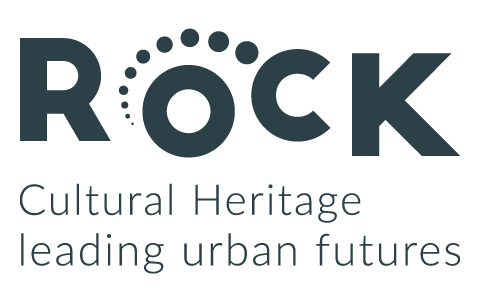Project facts
Presentation
ROCK has focused on historic city centres as real laboratories to demonstrate how Cultural Heritage (CH) can be an engine of regeneration, sustainable development and economic growth. It has applied a series of role-model practices in three testing sites in Bologna, Lisbon and Skopje, supporting the transformation of historic city centres afflicted by physical decay, social conflicts and poor life quality into Creative and Sustainable Districts.
Over almost four years, the ten ROCK cities have been developing innovative solutions that demonstrate how cultural heritage can be the driving force behind urban sustainability. They have been supported by project partners – as service providers and knowledge brokers – to test and advance tools and approaches aimed at shaping sustainable, CH-led urban futures. As a result, the project has provided an innovative, collaborative and systemic approach to promote the effective regeneration and adaptive reuse in historic city centres by implementing a repertoire of successful CH-led regeneration initiatives.
ROCK has worked on overcoming the idea of CH as an accessory investment and an object of isolated sectorial policies. Its aim has been to include CH in broader economic and development processes, such as a social economy and an increase in knowledge, creativity and overall quality of life.
The most important transformation processes triggered by ROCK have been the collective actions aimed at capturing urban transformation, as well as the dynamic construction of CH for all. As a result, the undertaken actions has fed processes of urban transformation involving the largest possible number of citizens.
The first goal has been to develop both a methodology and an operational framework (cultural, technological, managerial) valuable and effective in different urban realities. The application of these two shared elements has facilitated the comparison and collaboration between the 10 ROCK cities without inhibiting the site-specificity of places and communities, imposing a unique and standardized interpretative and operational model. A balance has been sought between, on the one hand, the sharing of methods and values in a European perspective and, on the other, the respect and enhancement of the specificity of places, attributing to the term "place" a broad interpretation that includes its physical, social, political, cultural and memorial structure.
Another objective has consisted in implementing pilot actions that, while supported by specialized and innovative skills, are not only able to intercept all the cultures of the city but also, in a circular process, to redefine themselves by supporting processes of empowerment and constant, mutual transfer of knowledge between specialized knowledge and ordinary "skills" of the "citizens", meaning by this term every actor operating in the city, whether his or her presence is stable or temporary.
The ROCK strategy
The ROCK strategy has been based on a research-action-research process, deployed into four complementary phases:
• Knowledge Inventory, aimed at providing a comprehensive framework of the Role Model Cities’ successful experiences in cultural heritage-led regeneration, through the Replicator Atlases and the Open Knowledge Portfolio.
• Sharing & Modelling, aimed at creating a link between the Role Models and the Replicators via the lesson learned through the mentoring process: these were organized in a Circular Urban Model, implemented in the Replicator Cities following a Living Lab approach, to achieve the foreseen Regenerative Scenarios.
• Piloting & Demonstration, in a learning-by-doing logic, this phase saw the Replicator Cities implement the piloting process in the demo-sites with the aim to achieve a cross-sector transformation. The actions implemented have followed three thematic axes: accessibility as autonomy, sustainability as care, collaboration as alliances.
• Assessment & Upscaling, to monitor and measure the progress of the whole process with soft and technological tools and to provide feedbacks to maximize the CH-led regeneration replicability
potential into: policy recommendations; RIS3 Strategies, governance toolkits and financial schemes.
These phases have followed a looped structure that starts from ROCK vision, aggregates the local ecosystem of stakeholders and enables multi-level regeneration models aimed at maximizing the impacts in each Replicator City. The key driver and operational objective of ROCK has been the coplanning of actions that allowed a co-production of the city (by decision makers and technicians but also by city actors and users) in a mutual recognition of visions, knowledge, skills.
In this perspective, the demonstration areas of the Replicator cities have been transformed into experimental labs where a systemic transformation process has been implemented and monitored to be eventually synthetized into three site-specific Integrated Management Plans (IMPs), aggregating shared principles, local strategies with site-specific CH-led regeneration tactics. The IMP have aimed at re-structuring the work and lessons learned from the implementation, in a medium-to-long-term vision for the local development and management of Cultural Heritage.
Impacts & Results
ROCK has proposed a change of perspective in the CH-led regeneration processes and implies a different attitude or use, with the main objectives of the reconstitution of community of practices and cultural ties.
In this sense, the public spaces of the historical city centres have represented a temporary instrument
that contributes in mediating differences, creating arenas of intercultural negotiation and co-creation, dialogic and transformative, and generate a sense of belonging and care for the cities' common goods.
At the same time, underused buildings have become new cultural epicenters for the renewal of the local community memories; neglected resources have been renovated and new services have been developed in a collaborative effort among the local ecosystem of stakeholders, the institutions, the universities and citizens themselves.
The research-action-research in ROCK represents a dynamic way to create new paths of knowledge to rethink the evolution of historical centers and prepare them for future challenges. In this perspective, the upgrade achieved by the ROCK project involves bringing the theme of CH back to the heart of primary political choices, placing the issue of memories and cultural identities of communities at the foundation of every economic and social program. Therefore, ROCK is putting on the spot the cascading role of identifying key piloting actions having impacts on the entire society.
The project impacts are wide:
- to improve new collaborations among stakeholders in order to meet shared goals
- to identify the enabling conditions, technologies and communication measures able to maximize the impacts. The project has involved 10 cities, more than a thousand of people, in knowledge creation, co-designing, co-construction and co-developing the future of CH in the cities. The cascading effects of this process include socio-economic outcomes in the rediscovering and reactivation of urban areas and their urban cultural heritage in previously neglected spaces, setting an important precedent in the new practices of citizen involvement and heritage valorization, contributing to the achievement of specific Sustainable Development Goals (SDGs).

